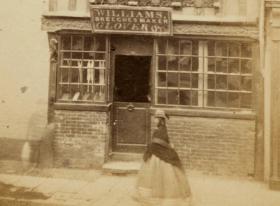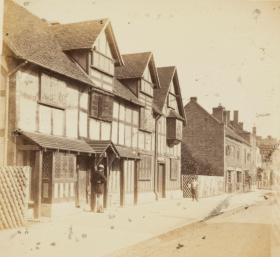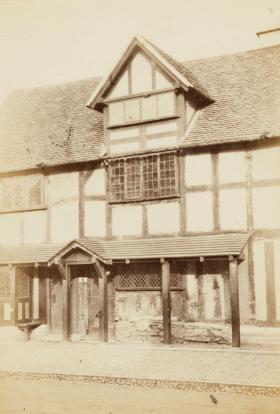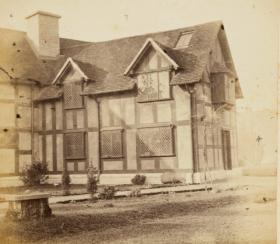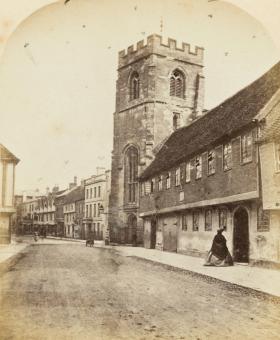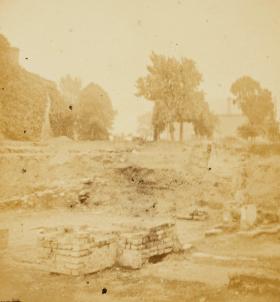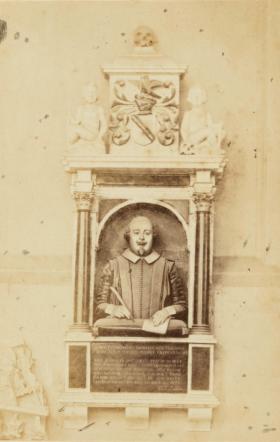Shakespeare's birthplace, home and grave: in pictures
In 1864 the Reverend John M. Jephson published his book on the birthplace, home, and grave of Shakespeare. Nestled within the pages of text are a series of photographs of sites relating to Shakespeare’s life in Stratford-on-Avon. For a photo-historian like myself these photographs are of particular interest because they predate the commercial continuous and half-tone printing processes we are all more familiar with today.
The fifteen images were all taken in 1863 by the well-known Victorian photographer Ernest Edwards. Each one is an albumen print stuck directly onto the page by hand. Commercial publishing of outdoor photography was still in its early years and these images are among the first to bring realistic images of Shakespeare’s birthplace and memorials into the public eye.
In the above detail we can get an idea of how difficult his task was. If you look carefully at the image you can see the fashionable lady in the centre of the image who must have remained motionless for some time, and to the left is the faint outline of a man holding a sack captured by the long exposure.
Even so, their early date and location in a relatively obscure publication means they are not as well-known as perhaps they should be. As a part of our Shakespeare commemorations this year we have reproduced some photographs from Jephson’s book for this post.
By the time of Jephson’s visit the bridge, the chapel, the church, the poet’s birthplace in Henley Street, and the old house in Chapel Street were the only visible remains of the period when Shakespeare lived here. In the picture above we can see Shakespeare’s birthplace but in his time the streets were not rows of brick cottages. Instead they were probably detached and surrounded by yards and gardens and numerous stately buildings owned by wealthy burghers, all built on the banks of a lovely river and surrounded by parks, villages and forest tracks.
When Shakespeare was born in 1564, his father was renting the Henley Street property while working as a farmer in nearby Snitterfield. In the same year the plague raged through the town killing many of the villagers. This seems to have opened up opportunities for John Shakespeare as ten years later he was able to purchase two freehold houses in Henley Street.
The timber house is substantially the same today but in Edwards’s photograph the house has already had new timber beams added and in the upstairs window to the room where Shakespeare was born there are more panes of glass. This may seem a minor detail but Jephson claims that in 1863, the walls of the room was covered in the signatures of visitors. And that Sir Walter Scott shunning the walls inscribed his name with a diamond on a pane of glass in the large window.
This image of the back garden of the Henley Street house shows the nicely laid out gravel walks and the carved stones rescued from the ruins of ‘New Place’. According to Jephson there had been an idea to fill the garden entirely with plants mentioned in Shakespeare's books but as we can see from the photo above this appears to have been abandoned.
Shakespeare attended the local Grammar School which which can be seen in the right foreground slightly overhanging the footpath. The tower was also part of the school but the children ascended the steps to the schoolroom in the building next to it. According to Jephson many commentators had highlighted the fact Shakespeare was taught in a chapel but this mode of education the same whether in a church, or separate building, as the schoolmaster was usually the local parish priest.
By 1863 the ruins above were all that remained of the home Shakespeare purchased in 1597 and named ‘New Place’. Intended as his retirement house it had originally been built in the reign of Henry Seventh by Sir Hugh Clopton, who lived his whole life there. After he died the house passed through a succession of owners; strangely they were all named William. After Sir Hugh it passed to his son William Clopton, then to William Boot, then William Underhill, and then to William Shakespeare.
After Shakespeare’s death it passed to a second Sir Hugh Clopton (a descendant of the original builder) who almost pulled the entire building down to rebuild it. In 1756 ownership passed to Reverend Francis Gastrell who became so annoyed at the continual stream of visitors and the thwarting of his plans to extend the garden that he simply demolished the house. The outraged locals eventually forced him to leave town but it was this property house that was purchased for the public by the Shakespeare Birthplace Trust in 1876. Unfortunately the only remaining parts in 1863 were the stone foundations of the main wall abutting chapel lane which we can see in this photograph. However the garden surrounding the house was preserved.
On the banks of the Avon River is the Holy Trinity Church where Shakespeare was baptised and his bones are buried. Next to him are the remains of his wife, Anne Hathaway and his eldest daughter Susanna. Within a few yards of the grave and against the north wall is the celebrated monument seen in the photo above. Many consider it to be the best likeness of the poet extant and Digges in his prefix to the first folio edition mentions it implying it must have been erected soon after his death.
According to Jephson the bust had been painted a stone colour to make it more look more classical but by 1863 this had been removed and the old colours restored. The hair, moustache, and beard were painted chestnut, the eyes brown, and his complexion given a ruddy hue. For a number of years it was thought the face was modelled from a death mask by Gerard Johnson. And this story can be dated back to 1849 when Ludwig Becker, a portrait painter from Darmstadt, brought a miniature oil painting of a corpse crowned with a laurel wreath to the British Museum. He believed it was of Shakespeare and had been taken from a death mask once in the possession of the Kesselstadt family of Cologne. Like many great stories these claims have been contested over the years. In 1904 the art historian M. H. Spielmann, in an Encyclopaedia Britannica article of 1904, expressed his disbelief. But as late as 1995 Professor Hildegard Hammerschmidt-Hummel, claimed it was authentic and even wrote a book on the subject.
References
Jephson, J., & Edwards, E. (1864). Shakespere, his birthplace, home, and grave : A pilgrimage to Stratford-on-Avon in the autumn of 1863 / by J.M. Jephson ; with photographic illustrations by Ernest Edwards. London: Lovell Reeve.

